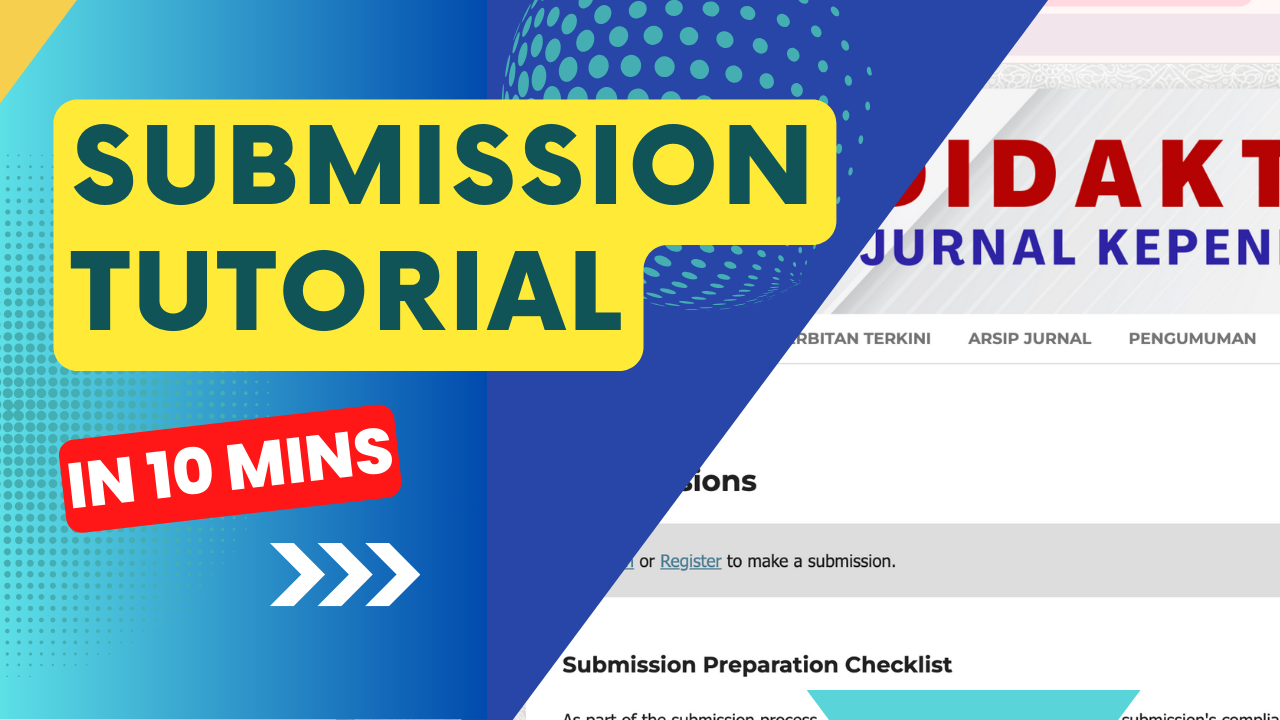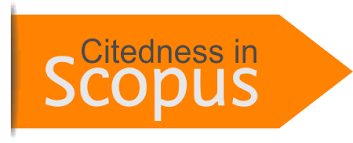Proses Berpikir Tahap Aksi dan Tahap Proses dalam Membangun Pemahaman Integral Mahasiswa Calon Guru
Abstract
Penelitian ini merupakan penelitian kualitatif yang bertujuan untuk menggambarkan pemahaman konsep integral mahasiswa calon guru melalui aksi dan proses ditinjau dari perbedaan gender. Subjek penelitian terdiri dari satu orang mahasiswa perempuan dan satu orang mahasiswa laki-laki. Data dikumpulkan melalui lembar tugas dan wawancara. Tahap aksi subjek perempuan ditunjukkan dengan penyelesaian integral tentu secara terurut sesuai rumus. Ketika menentukan luas daerah, subjek perempuan langsung menggunakan rumus integral dengan fungsi dan batas yang ada dalam masalah tanpa memperhatikan bentuk dan letak daerah yang dibentuk oleh kurva. Aksi subjek laki-laki ketika menentukan integral tentu adalah menghitung integral menggunakan rumus yang sesuai. Ketika menentukan luas daerah di bawah kurva, subjek laki-laki terlebih dahulu menggambarkan bentuk kurva yang dimaksud dan memperhatikan posisi daerah terhadap sumbu . Pada tahap proses, subjek perempuan mengenali terlebih dahulu bentuk integral yang diberikan dan selanjutnya menjelaskan langkah-langkah penyelesaiannya. Ketika menjelaskan cara menghitung luas daerah di bawah kurva, subjek perempuan menjelaskan langkah-langkah penyelesaian yakni menggunakan integral tentu dengan batas atas dan batas bawah yang ditentukan dalam soal tanpa memperhatikan posisi daerah. Sedangkan tahap proses subjek laki-laki ditunjukkan dengan menjelaskan cara menghitung luas daerah dengan diawali menggambar daerah yang dibatasi oleh kurva yang diberikan, memperhatikan posisi daerah terhadap sumbu , menentukan bentuk integral dengan batas-batas yang bersesuian dengan posisi daerah, dan selanjutnya menjelaskan langkah-langkah menghitung luas daerah menggunakan integral tentu.
Metrics
References
Arnon, I., Cottrill, J., & Dubinsky, E. (2014). APOS theory: A ramework for research and curriculum development in mathematics education. New York: Springer Science & Business Media
Bayraktar, F., Tutak, T., & İlhan, A. (n.d.). (2019). Elektronik eğitim bilimleri dergisi electronic journal of education sciences apos teorisine yönelik çalişmalarin bir analizi an analysis of the studies on the apos theory. www.ejedus.org
de Almeida, M. E. B., Queiruga-Dios, A., & Cáceres, M. J. (2021). Differential and integral calculus in first-year engineering students: A diagnosis to understand the failure. Mathematics, 9(1), 1–18. https://doi.org/10.3390/math9010061
Firdaus, A. M., Juniati, D., & Wijayanti, P. (2020). Number pattern generalization process by provincial mathematics olympiad winner students. Journal for the Education of Gifted Young Scientists, 8(3), 991–1003. https://doi.org/10.17478/jegys.704984
Firdaus, A. M., Murtafiah, W., Lukitasari, M., Lestari, N. D. S., Ernawati, T., & Widodo, S. A. (2023). Generalization of Patterns Drawing of High-Performance Students Based on Action, Process, Object, and Schema Theory. European Journal of Educational Research, 12(1), 421–433. https://doi.org/10.12973/eu-jer.12.1.421
Rodliyah, I., Juniati, D., & Khabibah, S. (2022). Analysis of the Level of Understanding of the Concept of the Isoline Method of Linear Program Material Based on APOS Theory in terms of Learning Interest. Jurnal Gantang, 7(2), 137–147. https://doi.org/10.31629/jg.v7i2.5250
Langi, E. L., Juniati, & Abadi. (2021). Understanding definite integral concepts of prospective teachers through actions and processes based on gender difference. Journal of Physics: Conference Series, 1747(1). https://doi.org/10.1088/1742-6596/1747/1/012026
Langi’, E. L., & Juniati, D. (2023). Students as Prospective Teachers’ Understanding of Integral Based on the APOS Theory in Terms of Gender Difference. In Journal of Higher Education Theory and Practice (Vol. 23, Issue 4).
Langi, E. L., Palayukan, H., & Palengka, I. (2022). Proses Berpikir Mahasiswa Calon Guru Matematika Dalam Menyelesaikan Soal Integral Berdasarkan Teori APOS. Seminar Nasional 2 Pendidikan Matematika UKI Toraja, 1–7.
Lestari, N. D. S., Juniati, D., & Suwarsono, S. (2018). Gender differences in prospective teachers’ mathematical literacy: Problem solving of occupational context on shipping company. Journal of Physics: Conference Series, 1008(1). https://doi.org/10.1088/1742-6596/1008/1/012074
Maharaj, A. (2014). An APOS analysis of natural science students’ understanding of integration. REDIMAT - Journal of Research in Mathematics Education, 3(1), 54–73. https://doi.org/10.4471/redimat.2014.40
Martínez-Planell, R., & Cruz Delgado, A. (2016). The unit circle approach to the construction of the sine and cosine functions and their inverses: An application of APOS theory. Journal of Mathematical Behavior, 43, 111–133. https://doi.org/10.1016/j.jmathb.2016.06.002
Martínez-Planell, R., & Trigueros, M. (2019). Using cycles of research in APOS: The case of functions of two variables. Journal of Mathematical Behavior. https://doi.org/10.1016/j.jmathb.2019.01.003
Misu, L., Budayasa, I. K., & Lukito, A. (2018). Profile of Metacognition of Mathematics and Mathematics Education Students in Understanding the Concept of Integral Calculus. Journal of Physics: Conference Series, 974(1). https://doi.org/10.1088/1742-6596/974/1/012022
Muhassanah, N., & Lukman, H. S. (2020). Analysis of mathematics student understanding: Calculus concepts. Journal of Physics: Conference Series, 1657(1). https://doi.org/10.1088/1742-6596/1657/1/012069
Oktaç, A. (2019). Mental constructions in linear algebra. ZDM, 51(7), 1043–1054.
Parraguez, M., & Oktaç, A. (2010). Construction of the vector space concept from the viewpoint of APOS theory. Linear Algebra and Its Applications, 432(8), 2112–2124. https://doi.org/10.1016/j.laa.2009.06.034
Priss, U. (2018). Combining and Contrasting Formal Concept Analysis and APOS Theory. Lecture Notes in Computer Science (Including Subseries Lecture Notes in Artificial Intelligence and Lecture Notes in Bioinformatics), 10872 LNAI, 96–104. https://doi.org/10.1007/978-3-319-91379-7_8
Puloo, M. M. L., Juniati, D., & Wijayanti, P. (2018). Visualization Profile of Junior High School Students in Solving Geometry Problems Viewed from Gender Differences. Journal of Physics: Conference Series, 1108(1). https://doi.org/10.1088/1742-6596/1108/1/012063
Salleh, T. S., & Zakaria, E. (2016). The Effects of Maple Integrated Strategy on Engineering Technology Students’ Understanding of Integral Calculus. In TOJET: The Turkish Online Journal of Educational Technology (Vol. 15, Issue 3).
Sari, D. I., Budayasa, I. K., & Juniati, D. (2017). The analysis of probability task completion; Taxonomy of probabilistic thinking-based across gender in elementary school students. AIP Conference Proceedings, 1868. https://doi.org/10.1063/1.4995131
Wulandari, F., & Rakhmawati, R. (2019). Desimal: Jurnal Matematika Analisis Kemampuan Pemahaman Relasional Matematis : Dampak Strategi Pembelajaran Index Card Match. 2(3), 203–209. http://ejournal.radenintan.ac.id/index.php/desimal/index
Yudianto, E., Suwarsono, S., & Juniati, D. (2017). The Anticipation: How to Solve Problem in Integral? Journal of Physics: Conference Series, 824(1). https://doi.org/10.1088/1742-6596/824/1/012055
Copyright (c) 2024 Evy Lalan Langi, Hersiyati Palayukan

This work is licensed under a Creative Commons Attribution 4.0 International License.
Dengan mengirimkan naskah artikel, berarti penulis setuju dengan segala kebijakan yang ditetapkan oleh jurnal dan penerbit.
Penulis menyatakan bahwa:
- kebijakan ini telah diketahui dan disetujui bersama oleh semua penulis;
- naskah artikel belum dipublikasikan secara resmi sebelumnya di media ber-ISSN atau ber-ISBN yang terdaftar, kecuali dalam bentuk abstrak atau sebagai bagian dari materi kuliah, atau skripsi/tesis/disertasi yang tidak diterbitkan;
- naskah tidak sedang dalam proses editorial dan dipertimbangkan untuk publikasi di tempat lain;
- publikasi naskah ini telah disetujui oleh semua penulis, institusi afiliasi penulis, otoritas yang bertanggung jawab, dan lembaga di mana kegiatan telah dilakukan;
- naskah berisi materi yang aman dari pelanggaran hak cipta;
Perjanjian Hak Cipta dan Lisensi
- Penulis memiliki hak cipta dan hak kepemilikan lainnya yang terkait dengan artikel.
- Penulis memiliki hak dan diizinkan untuk menggunakan substansi artikel untuk karya-karya penulis berikutnya, termasuk untuk keperluan bahan/materi kuliah dan buku.
- Penulis menyerahkan hak publikasi pertama kepada jurnal dengan di bawah Lisensi Creative Commons (CC BY 4.0).
Pernyataan Lisensi CC BY 4.0
Anda diperbolehkan:
- Berbagi — menyalin dan menyebarluaskan kembali materi ini dalam bentuk atau format apapun;
- Adaptasi — menggubah, mengubah, dan membuat turunan dari materi ini untuk kepentingan apapun, termasuk kepentingan komersial.
Pemberi lisensi tidak dapat mencabut ketentuan di atas sepanjang Anda mematuhi ketentuan lisensi berikut ini.
- Atribusi — Anda harus mencantumkan nama yang sesuai, mencantumkan tautan terhadap lisensi, dan menyatakan bahwa telah ada perubahan yang dilakukan. Anda dapat melakukan hal ini dengan cara yang sesuai, namun tidak mengisyaratkan bahwa pemberi lisensi mendukung Anda atau penggunaan Anda.
- Tidak ada pembatasan tambahan — Anda tidak dapat menggunakan ketentuan hukum atau sarana kontrol teknologi yang secara hukum membatasi orang lain untuk melakukan hal-hal yang diizinkan lisensi ini.





.png)








